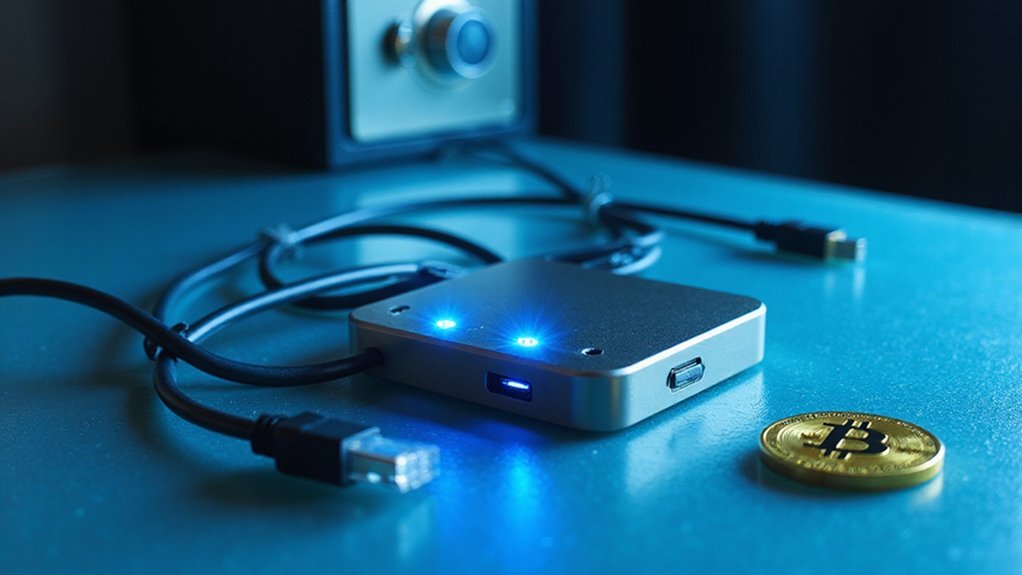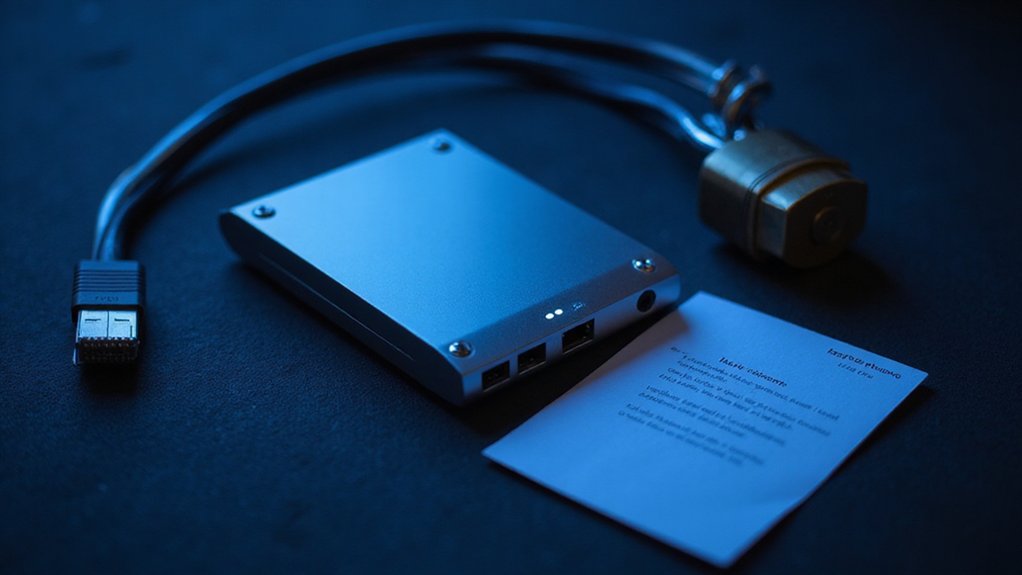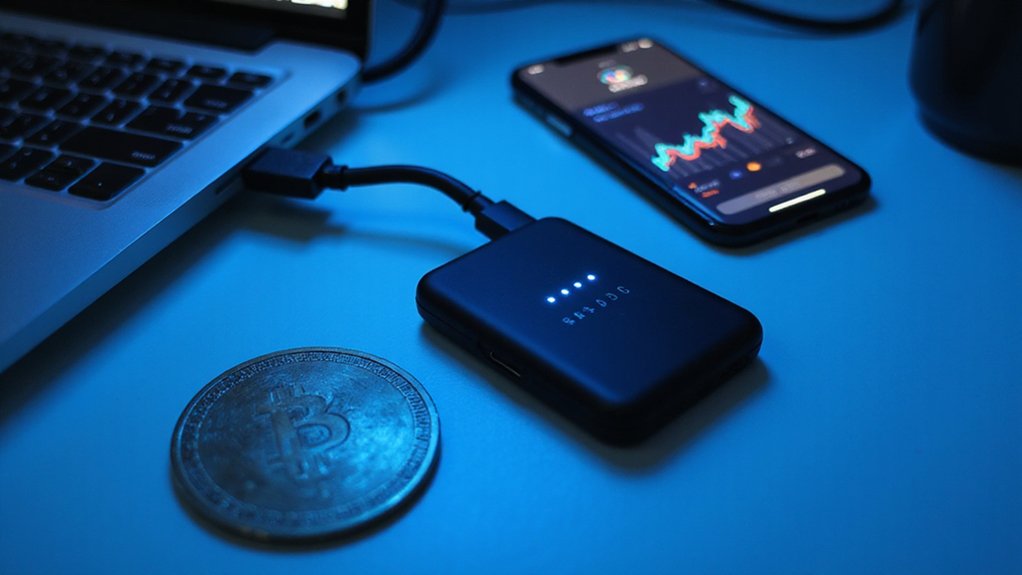A cold wallet functions as cryptocurrency’s fortified vault, storing private keys entirely offline—physically isolated from internet connectivity. Unlike their “hot” counterparts, these security-first solutions (typically hardware devices resembling USB drives) render digital assets virtually immune to online threats through elegant simplicity: what hackers can’t reach, they can’t steal. The operational friction of requiring physical access for transactions represents a small inconvenience for those serious about protecting digital fortunes that could otherwise vanish with alarming efficiency.

A cold wallet, the digital fortress of cryptocurrency storage, represents the financial equivalent of burying gold in one’s backyard—albeit with considerably more sophistication and far less digging.
These offline storage solutions fundamentally disconnect private keys—those precious alphanumeric sequences that prove ownership—from the internet’s perilous reaches, thereby creating an impenetrable barrier against the ubiquitous threat of online attacks.
The fortress of private keys stands resolute against digital marauders, severed from the internet’s endless assault by cold storage’s elegant simplicity.
While the crypto-curious might bemoan the inconvenience, seasoned investors recognize that this minor operational friction constitutes a small price to pay for genuine asset security.
The taxonomy of cold wallets encompasses several variations, each with distinct operational characteristics.
Hardware wallets—those seemingly innocuous USB devices—have emerged as the dominant form, offering robust protection without requiring one to become a cryptography expert.
Paper wallets, once hailed as revolutionary, have largely retreated to the annals of crypto history, victims of their own physical fragility.
For institutions managing substantial holdings (and who isn’t substantial in the post-2021 bull run?), air-gapped systems and multisignature arrangements provide additional security layers that would make Fort Knox envious.
Cold wallets execute their primary security function through offline transaction signing, a process whereby transmission details are approved without exposing private keys to internet-connected environments.
This isolation renders them effectively immune to malware, phishing attacks, and other digital malfeasance that regularly plagues their “hot” counterparts.
The trade-off, naturally, manifests in reduced accessibility—one cannot simply tap a smartphone screen to transfer assets when they’re secured in cold storage.
Businesses particularly benefit from cold storage solutions, as they facilitate compliance with increasingly stringent regulatory frameworks while simultaneously demonstrating prudent risk management to stakeholders and insurers alike.
Unlike cryptocurrencies, traditional banking provides protection through transaction tracking systems that can help recover stolen funds when theft occurs.
Many hardware wallets offer backup seed phrases as a recovery mechanism should the physical device become lost or damaged.
While certain pages from providers like Ledger.com may occasionally face page restrictions due to regional regulations such as those in the UK, these temporary inconveniences hardly diminish the fundamental security advantages of cold storage.
The contrast with hot wallets—perpetually connected, convenience-oriented interfaces—could not be starker; where hot wallets prioritize transaction speed and accessibility, cold wallets elevate security above all else.
In the volatile cryptocurrency ecosystem, where fortunes vanish with alarming regularity, this prioritization increasingly appears less paranoia and more fundamental wisdom.
Frequently Asked Questions
How Much Do Cold Wallets Typically Cost?
Cold wallets typically range from $50 to $200+, reflecting a marketplace where security comes at a premium (though it could be argued it’s a modest price for peace of mind).
Budget options like SafePal S1 ($49.99) serve cost-conscious users, while mid-tier devices such as Ledger Nano X ($149) offer enhanced features.
Premium models—Keystone Pro ($169) with fingerprint sensors and Trezor Model T ($219)—cater to those willing to pay for additional security sophistication and touchscreen interfaces.
Can Cold Wallets Be Hacked if Physically Stolen?
Cold wallets can indeed be compromised if physically stolen, though not without considerable effort.
While offline storage shields against remote attacks, physical possession enables sophisticated adversaries to attempt side-channel attacks or chip-level tampering.
Most devices incorporate countermeasures—PINs, passphrases, secure elements, and self-destruct mechanisms after failed attempts—creating substantial barriers.
The greatest vulnerability remains human: social engineering or coercion to extract PINs or seed phrases from owners often proves more effective than technical exploitation.
Do Cold Wallets Support All Cryptocurrencies?
Cold wallets don’t universally support all cryptocurrencies; their compatibility hinges on manufacturer specifications and firmware architecture.
While major cryptocurrencies (BTC, ETH, BNB, SOL) enjoy nearly universal support, altcoins and custom blockchain assets often require specific integration.
The hardware’s computational limitations, developer partnerships, and regulatory considerations further constrain token availability.
For unsupported assets, users typically resort to third-party middleware or open-source solutions that bridge compatibility gaps—a paradoxical convenience tax on what should be straightforward digital asset storage.
How Often Should I Update My Cold Wallet’s Firmware?
Cold wallet firmware updates should be applied immediately following official releases to patch vulnerabilities—a prudent approach that balances security maintenance with the “if it isn’t broken” philosophy that many crypto holders ironically cling to.
Quarterly checks serve as a minimum baseline, though high-value wallets merit more vigilant attention.
Critical security patches demand immediate implementation, regardless of schedule, while firmware should only be sourced from manufacturers’ official channels—a precaution that, surprisingly, still eludes some otherwise cautious investors.
Can I Recover Crypto if I Lose My Cold Wallet?
Crypto assets remain fully recoverable if one loses their cold wallet—provided they’ve safeguarded their seed phrase.
This 24-word mnemonic serves as the metaphorical skeleton key to the blockchain kingdom; without it, those digital assets effectively vanish into the ether (no pun intended).
While the physical device itself is replaceable, the seed phrase isn’t.
Institutional investors employ distributed backup systems, but individual holders must embrace the libertarian reality: self-custody means self-responsibility for recovery mechanisms.









